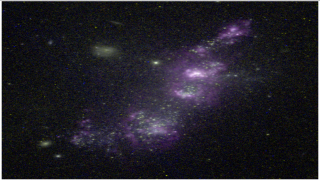Bibcode
Balmaverde, B.; Capetti, A.; Grandi, P.; Torresi, E.; Chiaberge, M.; Rodriguez-Zaurin, J.; Tremblay, G. R.; Axon, D. J.; Baum, S. A.; Giovannini, G.; Kharb, P.; Macchetto, F. D.; O'Dea, C. P.; Sparks, W.
Referencia bibliográfica
Astronomy and Astrophysics, Volume 545, id.A143
Fecha de publicación:
9
2012
Revista
Número de citas
32
Número de citas referidas
31
Descripción
We analyze Chandra observations of diffuse soft X-ray emission
associated with a complete sample of 3CR radio galaxies at z < 0.3.
We focus on the properties of the spectroscopic sub-classes of high
excitation galaxies (HEGs) and broad line objects (BLOs). Among the 33
HEGs we detect extended (or possibly extended) emission in about 40% of
the sources; the fraction is even higher (8/10) when restricting the
analysis to the objects with exposure times larger than 10 ks. In the 18
BLOs, extended emission is seen only in two objects; this lower
detection rate can be ascribed to the presence of their bright X-ray
nuclei that easily outshine any genuine diffuse emission. A very close
correspondence between the soft X-ray and optical line morphology
emerges. We also find that the ratio between [O III] and extended soft
X-ray luminosity is confined within a factor of 2 around a median value
of 5. Both results are similar to what is seen in Seyfert galaxies. We
discuss different processes that could explain the soft X-ray emission
and conclude that the photoionization of extended gas, coincident with
the narrow line region, is the favored mechanism.
Appendix A is available in electronic form at http://www.aanda.org
Proyectos relacionados

Grupo de Estudios de Formación Estelar GEFE
El proyecto interno GEFE está enmarcado en el proyecto coordinado, ESTALLIDOS, financiado por el plan nacional desde el año 2001. El ultimo proyecto aprobado es ESTALLIDOS 6.0 (AYA2016- 79724-C4-2-P). En el proyecto GEFE trabajamos en base al caso científico del proyecto ESTALLIDOS 6.0. Los estallidos de formación estelar (Starbursts o SB) son
Casiana
Muñoz Tuñón